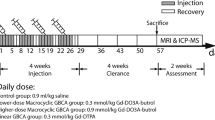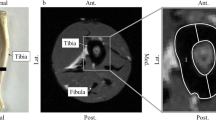Abstract
Objective
To investigate the feasibility of magnetization transfer (MT) imaging in mice in vivo for the assessment of cortical bone.
Materials and methods
MT-zero echo time data were acquired at 4.7 T in six mice using MT preparation pulses with two different flip angles (FAs) and a series of ten different off-resonance frequencies (500–15000 Hz). Regions of interest were drawn at multiple levels of the femoral cortical bone. The MT ratio (MTR) was computed for each combination of FAs and off-resonance frequencies. T1 measurements were used to estimate the direct saturation (DS) using a Bloch equation simulation. Estimation of the absorption line width of cortical bone from T2* measurements was also performed.
Results
MTR values were higher using 3000° FA than 1000° FA. MTR values decreased toward higher off-resonance frequencies. Maximum mean MTR ± standard deviation (SD) of 58.57 ± 5.22 (range 50.44–70.61) was measured with a preparation pulse of 3000° and off-resonance frequency of 500 Hz. Maximum “true” MT effect was estimated at around 2–3 and 5 kHz, respectively, for 1000° and 3000° FA. Mean full width at half maximum ± SD of 577 ± 91 Hz was calculated for the absorption spectral line of the cortical bone.
Conclusion
MT imaging can be used for the assessment of cortical bone in mice in vivo. DS effects are negligible using preparation pulses with off-resonance frequencies greater than 3 kHz.





Similar content being viewed by others
References
Martin RB, Ishida J (1989) The relative effects of collagen fiber orientation, porosity, density, and mineralization on bone strength. J Biomech 22(5):419–426
McCalden RW, McGeough JA, Barker MB, Court-Brown CM (1993) Age-related changes in the tensile properties of cortical bone. The relative importance of changes in porosity, mineralization, and microstructure. J Bone Joint Surg Am 75(8):1193–1205
Roschger P, Gupta HS, Berzlanovich A, Ittner G, Dempster DW, Fratzl P, Cosman F, Parisien M, Lindsay R, Nieves JW, Klaushofer K (2003) Constant mineralization density distribution in cancellous human bone. Bone 32(3):316–323
Faulkner KG (2000) Bone matters: are density increases necessary to reduce fracture risk? J Bone Miner Res 15(2):183–187. doi:10.1359/jbmr.2000.15.2.183
Schuit SC, van der Klift M, Weel AE, de Laet CE, Burger H, Seeman E, Hofman A, Uitterlinden AG, van Leeuwen JP, Pols HA (2004) Fracture incidence and association with bone mineral density in elderly men and women: the Rotterdam Study. Bone 34(1):195–202
Techawiboonwong A, Song HK, Leonard MB, Wehrli FW (2008) Cortical bone water: in vivo quantification with ultrashort echo-time MR imaging. Radiology 248(3):824–833. doi:10.1148/radiol.2482071995
Techawiboonwong A, Song HK, Wehrli FW (2008) In vivo MRI of submillisecond T(2) species with two-dimensional and three-dimensional radial sequences and applications to the measurement of cortical bone water. NMR Biomed 21(1):59–70. doi:10.1002/nbm.1179
Reichert IL, Robson MD, Gatehouse PD, He T, Chappell KE, Holmes J, Girgis S, Bydder GM (2005) Magnetic resonance imaging of cortical bone with ultrashort TE pulse sequences. Magn Reson Imaging 23(5):611–618. doi:10.1016/j.mri.2005.02.017
Weiger M, Pruessmann KP (2007) MRI with Zero Echo Time. In: eMagRes. Wiley, London. doi:10.1002/9780470034590.emrstm1292
Weiger M, Stampanoni M, Pruessmann KP (2013) Direct depiction of bone microstructure using MRI with zero echo time. Bone 54(1):44–47. doi:10.1016/j.bone.2013.01.027
Bae WC, Chen PC, Chung CB, Masuda K, D’Lima D, Du J (2012) Quantitative ultrashort echo time (UTE) MRI of human cortical bone: correlation with porosity and biomechanical properties. J Bone Miner Res 27(4):848–857. doi:10.1002/jbmr.1535
Horch RA, Nyman JS, Gochberg DF, Dortch RD, Does MD (2010) Characterization of 1H NMR signal in human cortical bone for magnetic resonance imaging. Magn Reson Med 64(3):680–687. doi:10.1002/mrm.22459
Horch RA, Gochberg DF, Nyman JS, Does MD (2011) Non-invasive predictors of human cortical bone mechanical properties: T(2)-discriminated H NMR compared with high resolution X-ray. PLoS ONE 6(1):e16359. doi:10.1371/journal.pone.0016359
Chang EY, Bae WC, Shao H, Biswas R, Li S, Chen J, Patil S, Healey R, D’Lima DD, Chung CB, Du J (2015) Ultrashort echo time magnetization transfer (UTE-MT) imaging of cortical bone. NMR Biomed 28(7):873–880. doi:10.1002/nbm.3316
Henkelman RM, Huang X, Xiang QS, Stanisz GJ, Swanson SD, Bronskill MJ (1993) Quantitative interpretation of magnetization transfer. Magn Reson Med 29(6):759–766
Henkelman RM, Stanisz GJ, Graham SJ (2001) Magnetization transfer in MRI: a review. NMR Biomed 14(2):57–64
Springer F, Martirosian P, Machann J, Schwenzer NF, Claussen CD, Schick F (2009) Magnetization transfer contrast imaging in bovine and human cortical bone applying an ultrashort echo time sequence at 3 Tesla. Magn Reson Med 61(5):1040–1048. doi:10.1002/mrm.21866
Diab T, Vashishth D (2005) Effects of damage morphology on cortical bone fragility. Bone 37(1):96–102. doi:10.1016/j.bone.2005.03.014
Bayne K (1996) Revised guide for the care and use of laboratory animals available. American Physiological Society. Physiologist 39(4):199, 208–211
Weiger M, Wu M, Wurnig MC, Kenkel D, Jungraithmayr W, Boss A, Pruessmann KP (2014) Rapid and robust pulmonary proton ZTE imaging in the mouse. NMR Biomed 27(9):1129–1134. doi:10.1002/nbm.3161
Gudbjartsson H, Patz S (1995) The Rician distribution of noisy MRI data. Magn Reson Med 34(6):910–914
Wurnig MC, Weiger M, Wu M, Kenkel D, Jungraithmayr W, Pruessmann KP, Boss A (2015) In vivo magnetization transfer imaging of the lung using a zero echo time sequence at 4.7 tesla in mice: initial experience. Magn Reson Med 76(1):156–162. doi:10.1002/mrm.25882
Horch RA, Gochberg DF, Nyman JS, Does MD (2012) Clinically compatible MRI strategies for discriminating bound and pore water in cortical bone. Magn Reson Med 68(6):1774–1784. doi:10.1002/mrm.24186
Chen J, Grogan SP, Shao H, D’Lima D, Bydder GM, Wu Z, Du J (2015) Evaluation of bound and pore water in cortical bone using ultrashort-TE MRI. NMR Biomed 28(12):1754–1762. doi:10.1002/nbm.3436
Manhard MK, Horch RA, Gochberg DF, Nyman JS, Does MD (2015) In vivo quantitative MR imaging of bound and pore water in cortical bone. Radiology 277(1):221–229. doi:10.1148/radiol.2015140336
Seifert AC, Wehrli SL, Wehrli FW (2015) Bi-component T2 * analysis of bound and pore bone water fractions fails at high field strengths. NMR Biomed 28(7):861–872. doi:10.1002/nbm.3305
Du J, Hermida JC, Diaz E, Corbeil J, Znamirowski R, D’Lima DD, Bydder GM (2013) Assessment of cortical bone with clinical and ultrashort echo time sequences. Magn Reson Med 70(3):697–704. doi:10.1002/mrm.24497
Ramani A, Dalton C, Miller DH, Tofts PS, Barker GJ (2002) Precise estimate of fundamental in vivo MT parameters in human brain in clinically feasible times. Magn Reson Imaging 20(10):721–731
Hodgson RJ, Evans R, Wright P, Grainger AJ, O’Connor PJ, Helliwell P, McGonagle D, Emery P, Robson MD (2011) Quantitative magnetization transfer ultrashort echo time imaging of the Achilles tendon. Magn Reson Med 65(5):1372–1376. doi:10.1002/mrm.22715
Sinclair CD, Samson RS, Thomas DL, Weiskopf N, Lutti A, Thornton JS, Golay X (2010) Quantitative magnetization transfer in in vivo healthy human skeletal muscle at 3 T. Magn Reson Med 64(6):1739–1748. doi:10.1002/mrm.22562
Tozer D, Ramani A, Barker GJ, Davies GR, Miller DH, Tofts PS (2003) Quantitative magnetization transfer mapping of bound protons in multiple sclerosis. Magn Reson Med 50(1):83–91. doi:10.1002/mrm.10514
Davies GR, Ramani A, Dalton CM, Tozer DJ, Wheeler-Kingshott CA, Barker GJ, Thompson AJ, Miller DH, Tofts PS (2003) Preliminary magnetic resonance study of the macromolecular proton fraction in white matter: a potential marker of myelin? Mult Scler 9(3):246–249
Wolff SD, Balaban RS (1989) Magnetization transfer contrast (MTC) and tissue water proton relaxation in vivo. Magn Reson Med 10(1):135–144
Horsfield MA, Barker GJ, Barkhof F, Miller DH, Thompson AJ, Filippi M (2003) Guidelines for using quantitative magnetization transfer magnetic resonance imaging for monitoring treatment of multiple sclerosis. J Imaging 17(4):389–397. doi:10.1002/jmri.10266
McDaniel JD, Ulmer JL, Prost RW, Franczak MB, Jaradeh S, Hamilton CA, Mark LP (1999) Magnetization transfer imaging of skeletal muscle in autosomal recessive limb girdle muscular dystrophy. J Comput Assist Tomogr 23(4):609–614
Barker GJ, Schreiber WG, Gass A, Ranjeva JP, Campi A, van Waesberghe JH, Franconi JM, Watt HC, Tofts PS (2005) A standardised method for measuring magnetisation transfer ratio on MR imagers from different manufacturers—the EuroMT sequence. MAGMA 18(2):76–80. doi:10.1007/s10334-004-0095-z
Weiskopf N, Suckling J, Williams G, Correia MM, Inkster B, Tait R, Ooi C, Bullmore ET, Lutti A (2013) Quantitative multi-parameter mapping of R1, PD(*), MT, and R2(*) at 3T: a multi-center validation. Front Neurosci 7:95. doi:10.3389/fnins.2013.00095
Martirosian P, Boss A, Deimling M, Kiefer B, Schraml C, Schwenzer NF, Claussen CD, Schick F (2008) Systematic variation of off-resonance prepulses for clinical magnetization transfer contrast imaging at 0.2, 1.5, and 3.0 tesla. Invest Radiol 43(1):16–26. doi:10.1097/RLI.0b013e3181559949
Syha R, Martirosian P, Ketelsen D, Grosse U, Claussen CD, Schick F, Springer F (2011) Magnetization transfer in human Achilles tendon assessed by a 3D ultrashort echo time sequence: quantitative examinations in healthy volunteers at 3T. Rofo 183(11):1043–1050. doi:10.1055/s-0031-1281742
Author information
Authors and Affiliations
Corresponding author
Ethics declarations
Funding
We acknowledge the support of the Clinical Research Priority Program (CRPP) Molecular Imaging Network Zurich (MINZ) and the funding of the Swiss National Science Foundation (Nr. 31003A_162533).
Conflict of interest
The authors declare that they have no conflict of interests.
Ethical approval
All applicable international, national and/or institutional guidelines for the care and use of animals were followed.
Rights and permissions
About this article
Cite this article
Marcon, M., Weiger, M., Keller, D. et al. Magnetization transfer imaging of cortical bone in vivo using a zero echo time sequence in mice at 4.7 T: a feasibility study. Magn Reson Mater Phy 29, 853–862 (2016). https://doi.org/10.1007/s10334-016-0577-9
Received:
Revised:
Accepted:
Published:
Issue Date:
DOI: https://doi.org/10.1007/s10334-016-0577-9




